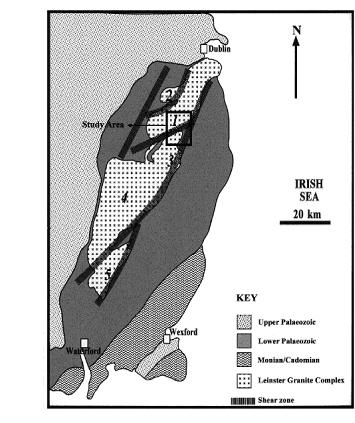Joint Ireland Wales Branches Field
trip 2008 : The Granites of the Wicklow Mountains
Five members of GCOUGS joined many members of the Ireland Branch in
Wicklow at Easter to explore the granite facies of these stunning
mountains. Torrential rain on the first morning did nothing to
quench our enthusiasm for our first international fieldtrip. We
would like to thank the Ireland Branch, in particular Phyllis
Turkington, for welcoming us, for arranging an excellent leader in
Michael John O’Mahoney and for organising our accommodation at the
Glendalough Hotel which has a spectacular setting. The trip was
thoroughly enjoyed by all.
The Leinster Granite in South East Ireland is the largest outcropping
granitoid complex in the British Isles with an area of
1500km². Geophysical surveys indicate a continuation to the
South west under the Upper Palaeozoic. The granite complex
intrudes the Lower Palaeozoic which comprises, according to Michael
John’s article, “a complex marginal sequence of metasedimentary and
metaigneous domains of Avalonian/Iapetus affinities which have
undergone pre-granite green schist metamorphism”. Wow! The
Iapetus suture zone lies to the north west but the boundary is unclear
due to the extensive Lower Carboniferous cover and complex Iapetus
closure history. It is thought that closure caused the base of
the crust to melt to create granites and the geochemical and isotope
studies indicate derivation from partial melt. Around the granite
there is a contact aureole of garnet, biotite, andalusite, staurolite,
cordierite, muscovite, tourmaline and other minerals.
At the hotel on the Friday evening Michael gave us flavours of what was
to come; the granite complex is divided into five plutons (see map
below) which are arranged in en eschelon fashion obliquely to the
regional Caledonion trend in the country rocks. These have
undergone a complex tectonic history through the Lower Palaeozoic and
the granites have been emplaced post orogenically. The units are
often separated from one another by schist zones. Many granite
facies can be observed due this probable island arc tectonic setting
where mixing of different melt creates interesting and varied textures
as a result of thermal and compositional differences.

Five granite units separated by schist shear zones, after O’Mahoney,
2001.
Out in the field along the Glendalough Valley we observed the small
folds of the siltstone/mudstone country rocks close to Glendalough and
as we progressed along the valley into the hills the rocks became more
granitic. Michael pointed out appinite blocks up on Camaderry
Mountain identified by a change of vegetation. The geological
divide between granite and schist is clearly visible in places like
Glendalough where coarse granite boulder scree suddenly gives way to
smoother shiny schist. At the west end of the Upper Lake lie the
ruins of an abandoned miners' village where the mining of lead took
place from 1850 until about 1957. Lots of minerals were spotted
in the spoil heaps.
Mining was also in evidence at our second stop at Glendasan in a
parallel valley towards the Wicklow Gap. Here we observed the
contact between the Lugnaquilla and the Ribband units and highly
strained granites were in evidence. At the Wicklow Gap we saw
greseining or elongated quartz crystals in the granite which indicated
deformation at emplacement. Here the schist septum was visible as
more rugged landscape in contrast to the smooth granite outcrops on
either side. Passing further west to Hollywood and along a
forestry track, we experienced the western contact of the granite of
unit 1, metasediments and along the road, high above, vertical bedding
and other country rock structures were clearly visible.
On Sunday morning we drove to the stunning Glenmacnass waterfall where
we closely observed ‘megacrystic granites cross cutting high strain
gneissose granite’ outcropping along the road cutting. The views
from the top of the waterfall along the glen were superb and we were
able to see the contact of the northern unit 1 with the Ribband Group
quite clearly delineated by outcrop and vegetation zoning. We
drove along the panoramic Sally Gap and at Brockagh mountain we
were delighted to find good examples of coticule…..neatly folded quartz
veins associated with this kind of granite setting but still remaining
somewhat of a mystery to most of us! Excellent photos are
included here from Tony James.
Coticule
Glenmacnass in schist with waterfall in granite.
References:
Grogan, S.E. and Reavy, R.J., Disequilibrium textures of the Leinster
Granite Complex, SE Ireland: evidence of acid-acid magma mixing.
Mineralogical magazine, December, 2002, Vol 6, p929-939.
O’Mahoney, M.J., (2002) The Structure and Metamorphic features of the
Central and Southern Units of the Leinster Granite Complex, SE Ireland,
Unpub. PhD thesis, NUI, Cork.